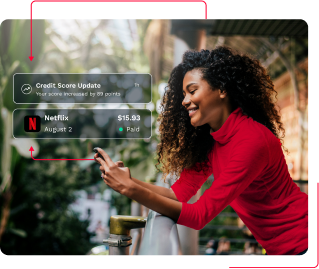Ready to use your credit score to unlock your dream home? Dive into this guide and explore how your credit score paves the way for lower interest rates, bigger loans, and smoother sailing toward that “Sold!” sign.
Remember, homeownership is unique for everyone. This toolkit equips you with the knowledge and resources to use credit to make your dream a reality — no matter where you are in your financial journey. Let’s get started!
Step 1: Start With the Basics — What’s Your Credit Score?
Before taking the leap into homeownership, it’s crucial to understand your credit score.
This three-digit number, ranging from 300 to 850, tells lenders how likely you are to repay debts like a mortgage. Think of it like a report card for your financial history. A higher score is like getting a better grade. The higher your score, the more financial opportunities open up.
You can get your free credit report at AnnualCreditReport.com. Many banks also give you free access to your credit score through their online banking portal or app.
The most common credit scoring systems are FICO® and VantageScore®.
Both FICO and VantageScore measure your creditworthiness, but they prioritize different aspects. FICO, the classic, heavily weighs past borrowing habits like payment history and credit history length, while VantageScore, which is newer, also considers your current financial situation like available credit.
Step 2: Understand the Credit and Homeownership Connection
Lenders, the gatekeepers of homeownership, use your credit score to evaluate your ability to repay a home loan.
Mortgage lenders generally want to see a credit score above a 670. The better your score, the better your chances are of getting perks like lower interest rates and reduced private mortgage insurance rates.
Remember, your score is just one piece of the puzzle. Lenders also consider your income, debt, and down payment.
Step 3: Navigate the Loan Maze — Eligibility and Rates
If your credit score is on the lower end, lenders might see your loan as a bit of a risk. This could limit how much you can borrow, even if your paycheck shows you can afford the mortgage.
Interest rates add another layer to the plot. A lower credit score might mean higher interest rates, as lenders want to safeguard themselves in case you’re not able to pay.
A larger down payment might be on the cards if your credit score isn’t as high as a lender would like it to be. Remember, this credit score dance also influences home insurance and property taxes, shaping your monthly payment.
The good part is that your credit score isn’t set in stone. You have the power to improve it with good financial habits. More on that in a bit.
Step 4: Crunching the Numbers on Monthly Payments
Picture this: You have great credit, locking in a 6% interest rate on a $200,000 loan. Your monthly payment? A solid $1,200.
Now, imagine your credit isn’t quite where you want it to be, and your lender hikes the interest rate to 7.5% to play it safe. Suddenly, your monthly payment jumps to $1,400 — a $200 increase. That’s how much of an impact your score can have.
Step 5: Options for All Credit Types
Even if your credit score where you want it to be, there are other paths to homeownership, even with a less-than-stellar score. Here are some options to explore:
- Government-backed loans: Programs like Federal Housing Administration (FHA) loans and United States Department of Agriculture (USDA) loans have lower credit score requirements than conventional mortgages. They may also offer down payment assistance or other incentives for first-time buyers.
- State and local programs: Many states and municipalities offer affordable housing programs for first-time buyers with low to moderate incomes. These programs may offer grants, low-interest loans, or tax breaks.
- Credit building tools: StellarFi is a tool that helps you build your credit score by giving you credit for the everyday bills you already pay — like utilities, streaming services, and rent. StellarFi reports these on-time payments to the major credit bureaus each month to help increase your score while building your payment history and improving your credit utilization rate.
- Non-traditional lenders: Some credit unions and online lenders may be more flexible than traditional banks when it comes to credit score requirements, especially for first-time buyers.
Step 6: Craft Your Credit Game Plan
Whether your dream home is on the horizon or a distant vision, it’s time to boost your credit game. Check your credit report on a reputable site to identify the culprits — unpaid bills or a hefty credit card balance. Steer clear of quick-fix traps promising rapid credit improvement. StellarFi offers credit improvement through consistent good financial behaviors.
Here are a few steps you can take to improve you credit score:
- Track and understand: Grab your free credit report and analyze the factors dragging down your score.
- Pay on time: Set up auto-payments or prioritize timely payments to avoid late marks.
- Trim the fat: Keep credit card balances low and consider strategic limit increases.
- Clean up your report: Dispute errors and negotiate settlements to remove negative marks.
Conclusion: Your Dream Home is Possible
Building a robust credit score lays the groundwork for unlocking the doors to your dream home. Start preparing for this thrilling journey now, even if the red carpet moment is a few months or years away.


